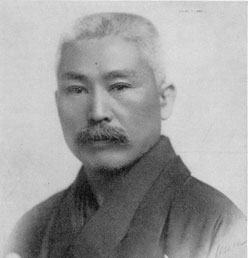Black Dragon Society facts for kids
| Formation | 1901 |
|---|---|
| Founder | Uchida Ryohei |
| Founded at | Japan |
| Type | Political |
| Location |
|
| Fields | Politics |
The Black Dragon Society (called Kokuryūkai in Japanese) was a very strong and nationalistic group in Japan. It was also known as the Amur River Society. This group was made up of civilians but often acted like a military force. Its main goal was to make Japan more powerful and important, especially in Asia.
Contents
The Black Dragon Society's Story
The Kokuryūkai was started in 1901 by a martial artist named Ryōhei Uchida. He followed in the footsteps of his teacher, Mitsuru Tōyama, who had a group called the Gen'yōsha.
The group got its name from the Amur River. This river is called "Black Dragon River" in Chinese, which is Kokuryū-kō in Japanese.
At first, the Black Dragon Society wanted to keep the Russian Empire from expanding into East Asia, especially north of the Amur River. They also tried to be different from the earlier Gen'yōsha group, which sometimes used illegal methods. However, over time, the Black Dragon Society also found that using less conventional ways helped them achieve their goals.
How They Operated
The Society published its own newspaper, called the Kokuryū Kaiho (Amur Bulletin). They also ran a special school to train agents. These agents were sent to gather secret information about Russia's activities in places like Russia, Manchuria, Korea, and China. One important member, Ikki Kita, was sent to China.
The Black Dragon Society also put pressure on Japanese politicians to have a strong foreign policy. They supported the idea of Pan-Asianism, which meant uniting Asian countries. They even gave money to revolutionaries like Sun Yat-sen and Emilio Aguinaldo.
Their Role in Wars
During the Russo-Japanese War and other conflicts, the Imperial Japanese Army used the Black Dragon Society's network. They helped with espionage (spying), sabotage (damaging enemy property), and even assassination. They also organized local fighters against the Russians.
The Black Dragons were very good at psychological warfare. This means they spread false information and propaganda to influence people's minds. They also helped the Japanese army by working as interpreters.
They worked with a Japanese spy named Colonel Akashi Motojiro. Akashi had contacts all over the Muslim world and Central Asia, which the Black Dragons helped maintain even during World War II. They also made strong connections with Buddhist groups across Asia.
Changing Goals
In the 1920s and 1930s, the Kokuryūkai became more of a regular political group. They openly spoke out against liberal and leftist ideas. Even though they didn't have many members, their close ties to important government officials, military leaders, and powerful business people gave them a lot of influence.
In 1924, some members invited Oomoto leader Onisaburo Deguchi and Aikido founder Morihei Ueshiba on a trip to Mongolia.
At first, the group focused only on Russia. But in the 1930s, the Kokuryūkai expanded its activities worldwide. They sent agents to many different places, including Ethiopia, Turkey, Morocco, all over Southeast Asia, South America, Europe, and the United States.
The Black Dragon Society was officially shut down by the American forces occupying Japan in 1946. Later, in 1961, a group called the Black Dragon Club (Kokuryū-Kurabu) was formed. It aimed to continue the spirit of the original society, but it never had more than 150 members.
Activities in the United States
Some African-American groups, like the Ethiopian Pacific Movement and the Peace Movement of Ethiopia, said they were connected to the Black Dragon Society.
The Black Dragon Society sent an agent named Satokata Takahashi to the United States. He promoted the idea of pan-Asianism and claimed that Japan would treat African Americans as equals. He became a supporter of Elijah Muhammad and the Nation of Islam, as well as the Pacific Movement of the Eastern World.
Mittie Maude Lena Gordon, who led the Peace Movement of Ethiopia, also claimed to have a personal connection with the Kokuryūkai.
On March 27, 1942, FBI agents arrested members of the Black Dragon Society in California.
Inside the Manzanar Internment Camp, a small group of people who supported Imperial Japan flew Black Dragon flags. They also tried to scare other Japanese inmates.
See also
 In Spanish: Sociedad del Dragón Negro para niños
In Spanish: Sociedad del Dragón Negro para niños


